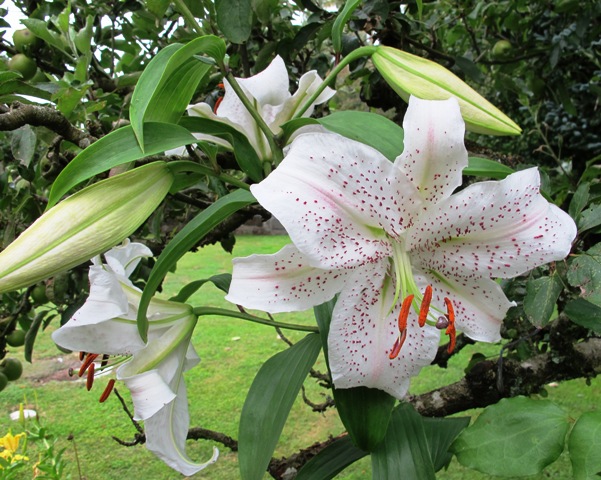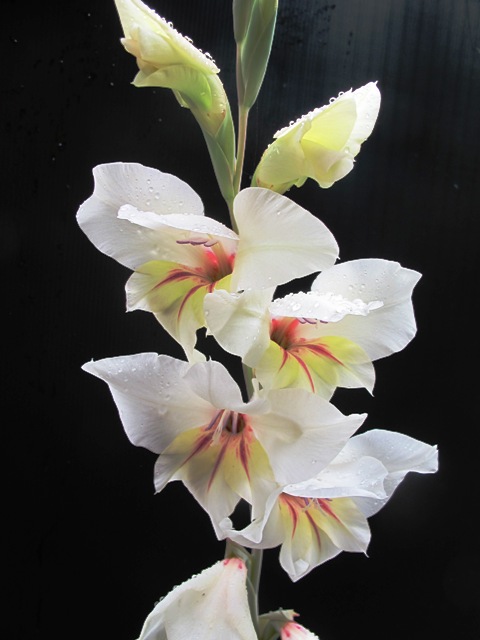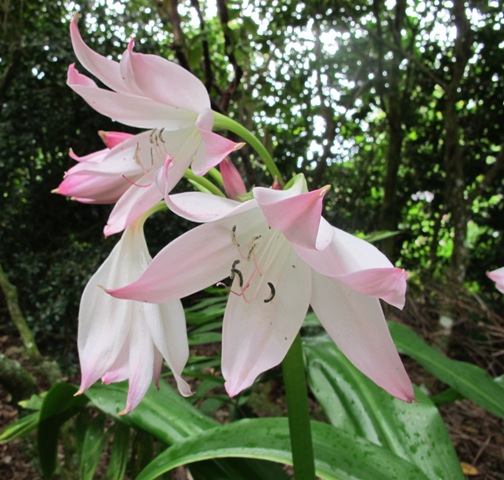
Alchemilla mollis in my garden
I photographed my patch of Alchemilla mollis for my friend, Chris. He, too, had admired the acid yellow froth in English gardens and wanted the same effect in his own home garden but found his efforts were not rewarded. This is as good as I can get it here.

Alchemilla mollis at Blooms of Bressingham in the UK
I do not understand why it never seems as lush. It originates from southern Europe so is presumably not dependent on winter chill. though maybe there are chillier areas in southern Europe because it certainly seems to perform better in cooler places with lower light levels. I even wondered briefly if what we grow in New Zealand as A. mollis is in fact its smaller cousin, Alchemilla erythropoda. But apparently the latter is much, much smaller so I guess not. It is A.mollis, but not as northern gardeners grow it.

Do not laugh at this poor little specimen of a veronicastrum. A lot of effort has gone in to getting it to this stage. The bamboo stakes were part of rabbit protection when it was even smaller.
I have written before about our single, solitary specimen of the blue veronicastrum, V. virginicum, which we have nursed through from seed to its second summer. It is even setting flower buds. It is just that the plant is only 20cm tall when it should be hitting two metres in bloom. It is clearly not a rapid grower and I wonder if northern gardeners buy established plants to start with. It is a common, hardy, American plant and nowhere in the international literature do I see mention of it being difficult to establish.

This was more the effect I was hoping for – at Le Jardin Plume in Normandy

This stronger blue veronicastrum, which will be a named form, was used by Piet Oudolf in Trentham Gardens near Stoke-on-Trent in the UK
We sourced two different packets of seed which disconcerted Mark when he came to sow them because they were so fine he got out his magnifying glass to check that he wasn’t just sowing dust. Despite being a professional at dealing with seed and going to the trouble of stratifying them in the fridge, he only ended up with this one, solitary plant. Time will tell whether it gets more strength and grows large enough for us to divide it. In the meantime, Mark is trying it from cutting as well. It is a plant we would like to use in our summer gardens but I would have expected it to be a little more enthusiastic in its second summer. In fact, I thought it would be a lot more robust and vigorous.
Astrantias are another mainstay of English summer gardens that we have tried and failed with. They flower and then just fade away. Heucheras are another plant that we have given up on. Once planted out in the garden, the lush nursery specimens just quietly sat and languished, failing to thrive. There is no substitute for trialling plants before investing too much money, time and energy on using them on a larger scale.

Scadoxus multiflorus ssp katherinae naturalising in our woodland
But I mustn’t moan. We do have our successes. I am pretty sure some successful growers of the aforementioned perennials would look with awe and envy at our summer display of Scadoxus katherinae. We will have only started with a few bulbs, possibly just the one at the very beginning, and we certainly didn’t plant this large swathe in the woodland. They have just gently seeded down and spread a little more year by year without ever causing a problem. They have very large bulbs (of a similar size to a belladonna) which sit close to the surface and stay evergreen with that large, lush foliage for much of the year.

Gloriosa superba prefers full sun and has also gently spread itself around
Ditto the Gloriosa superba, at times a little more problematic with their natural seeding. They are one of the types of tuber that finds their own depth in the soil and they bury themselves really deeply. This can make them difficult to get out if they are in the wrong place. But when they bloom with that lovely reflexed shape, it is like having fiery coronets in the garden.

Jacaranda! In Tikorangi! We are not exactly within its normal climatic range of conditions
The jacaranda tree is having a good flowering this year, albeit not as spectacular as in drier, hotter climates. I love jacarandas so to have one that blooms in our conditions is a great pleasure. Blue flowered trees are not common when you think about it and the carpet of fallen blooms beneath is also a delight.

Pretty much the only flower I cut to bring indoors and one stem fills a vase and scents a room. We have hundreds in the garden.
And we are into the season of the auratum lilies. I pick some to bring indoors to scent the house and truly, they are gorgeous. We have hundreds of these in the garden AND NO LILY BEETLE IN NZ! For this we are truly grateful and thank our tough border control. Their peak blooming over the next weeks will more than compensate for the absent astrantias, hopeless heuchera, anticlimactic alchemilla and the very disappointing veronicastrum.










